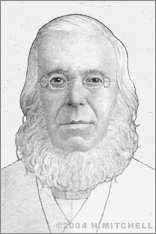Peter Cooper
Jell-O
Peter Cooper is credited with the invention of one of the most uniquely American desserts of all time: “Jell-O.” Cooper was an engineer and philanthropist, active in politics and community affairs and known for a variety of inventions and accomplishments. He was born in New York City on February 12, 1791 and grew up in Peekskill, New York. He had no formal training, but as a young man, he worked with his father and mastered a variety of skills in masonry, hatmaking, and machinery.
Cooper’s mechanical aptitude and entrepreneurial spirit led him to start several businesses including a furniture factory, glue-making factory, mining company, and grocery business. One of his most significant accomplishments was the development of the “Tom Thumb” prototype train, the first steam locomotive. Cooper began building it in 1828 at his iron works business in Baltimore. It was the first model that proved the potential of steam-powered rail transport and helped to accelerate the spread of railroads throughout the country. He was an influential industrialist with many inventions to his credit, including the rotary steam engine, a musical cradle, methods for making salt and glue, and a number of other mining and manufacturing processes.
In 1845, he obtained a patent for the manufacturing of gelatin. Gelatin itself was discovered much earlier, having been referenced by a French researcher in the 17th century who created it by boiling animal bones. The gelatinous substance that separates from the bones is pure protein, and today it has a multitude of uses in the food, cosmetics, pharmaceuticals, and photography industries. While Cooper patented its manufacturing, he did little to commercialize it. He packaged it for sales to cooks, but there was little interest in the product. He sold the patent to Pearl Wait, a cough syrup maker, in 1895.
Wait developed fruit-flavored versions of Cooper’s gelatin, and his wife devised the name “Jell-O” for the product. Despite his attempts to market it to cooks, interest was still low, so he sold the business to Francis Woodward in 1897, who in 1900 began advertising it heavily. By 1906, Jell-O sales reached nearly $1 million. In 1923, Woodward’s Genesee Pure Food Company was renamed Jell-O Company, and it eventually combined with Postum Cereal to become the General Foods Corporation.
Cooper's legacy continued to grow throughout his life. In the 1850s, he was president of the New York, Newfoundland, & London Telegraph Company and the North American Telegraph Company. He was involved in the 1858 project that resulted in the installation of the first trans-Atlantic cable telegraph. In 1876, he was the Greenback Party's candidate for president, and in 1859, Cooper established New York’s Cooper Union for the Advancement of Science and Art, which provided free education to adults in art and technology. The institute still operates today, granting scholarships to students with talent in fields such as engineering and architecture.
Cooper died in New York on April 4, 1883 at the age of 92.


